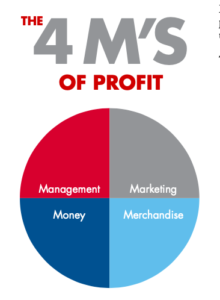The next chapter from our Guide to Building Resilience in Your Business.
The best business strategist in the world would fail without profit. Preserving profits when economic conditions aren’t good is essential. By adhering to the “Four M’s of Profit”, it can help to guarantee success even through tough times.
Management
All profitable companies have a strong management team. Effective management requires a plan for employee and team training, a useful and up-to-date database of customers and contacts, a strong budget, great accounting practices and planned use of time and resources.
Intelligent managers know how to systemise routine procedures while humanising the exceptions. For example, while customer services systems should be consistent and follow written guidelines and rules, customer service also depends upon well-trained humans to solve the problems that are unexpected or out of the ordinary. They do this by understanding the core values of the company and internalising those to beneficially represent the business under all circumstances.
Money
Strategies for dealing with money will make or break profitability. A successful approach to managing money will involve several key components. Those include auditing costs and setting budgets that are understood and followed by everyone in the business. Next, margins need to be increased – even if only gradually – in order to fatten profits. By keeping prices stagnant the average business will begin to lose money automatically, just because of the demands placed on money by ordinary annual inflation.
A better approach is to proactively raise prices, concentrate on enhanced customer service to justify the increases, and in that way dramatically boost net profits without alienating customers. Discounts and giveaways should be discontinued, but replaced with profitable programs such as in-house financing and credit card acceptance to make it easier for customers to buy and pay for their purchases.
Marketing
Marketing should be not so much about selling, but more about buying. Marketing of products and services is too often done solely from the perspective of the seller, rather than the buyer or customer, and those marketing campaigns seldom work. Those businesses that focus on marketing as a form of customer service will tap into the needs and desires of their targeted audience in a way that translates more easily into increased business and revenue.
Customer-centric marketing revolves around offering real value, but it also involves strategies like “upselling” to customers. They buy a deluxe model versus a standard model, for instance, and pay a premium in order to enjoy bigger benefits from the upgrade. Another example is “cross-selling” – where a company sells other products to enhance the primary purchase. Rather than just buying the burger, for example, the customer also buys fries and a soft drink to go with it. A third example is “down- selling,” which works well when a customer might otherwise not buy anything. Accommodate their budgetary demands and make a customer for life, rather than trying to sell them what they can’t afford and losing them to a competitor.
Merchandise
Taking a top-down or macro view of business merchandise can be a valuable exercise for a business owner, because the products and services sold help both define the entire business model as well as guide the direction of sales and revenue. When given a choice between one item of merchandise and another, look at the potential profit margins and choose the one that delivers the most bang for the buck.
Sales of computer printers, for example, slowed down after most consumers bought one, because they do not need to be replaced very often. However, ink has to be replaced continually, which is why most manufacturers focus on selling ink rather than printers. They will practically give away a printer just to snag a customer who will have to return again and again to buy ink refills. In other words, these printer manufacturers used to be in the printer business, and they sold ink to promote that product. Now they are in the ink business, and they sell printers in order to support their new business model. All the while they are making profit by knowing where it comes from and how to nab it.
Identify which products are profitable, and focus on selling those. Other ways to manage merchandise include stocking only higher priced and faster-moving items in the inventory, selling exclusive lines that others don’t offer, and carrying private label merchandise. Selling only quality merchandise – and making that part of an overall brand identity – is always a wise approach, and it can generally deliver higher margins because people pay more for prestige, status, and excellence.
This blog post is part of our ActionCOACH guide ‘Building Resilience’ that can be downloaded here





